Angelfish (Pterophyllum scalare) are unique freshwater cichlid species originally from South America. They are the most popular freshwater species with tall fins and glossy scales. Angelfish tend to be colorful, thin, and grow to about six inches long. These fish are peaceful when are kept in the aquarium with their own species and don’t like other very small species, especially with a lifespan of up to a decade.
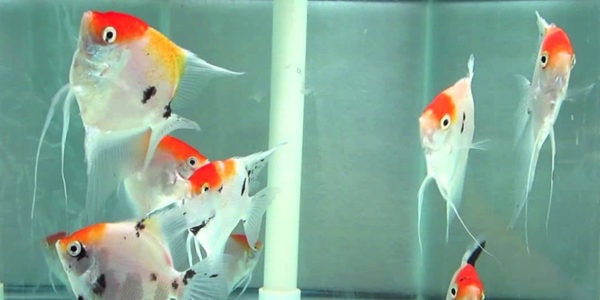
Table of Contents
Angelfish Overview
Angelfish prefer a minimum tank size of 20-gallons and taller aquariums are recommended instead of a wide one. Temperature ranges of 23-280Celsius (73-82° Fahrenheit) and an acidic pH (6-7) are ideal for the fish. These fish can live peacefully and enjoy intensively planted aquariums. Small fish and fin-nipping fish shouldn’t be kept with angelfish in the same aquarium since they tend to show aggressive behavior if the tank is overcrowded.
Besides, in crowded aquariums the water sullies and the ammonia level increases quickly. Therefore, it is fundamental to check the water weekly for ammonia levels and perform weekly water replacement and filter media should be replaced weekly.
| Information chart | Angelfish |
| Scientific name | Pterophyllum |
| Family | Cichlidae |
| Care level | Easy |
| Temperament | Medium difficult |
| Color | Silver, or gold with three choppy black bands |
| Lifespan | 10 years |
| Size | 6 in (15.24 cm) |
| Diet | Worms and small crustaceans. They are omnivores and will thrive on Aqueon Tropical Flakes, Color Flakes, Tropical Granules, and Shrimp Pellets. |
| Minimum tank size | 30 gallons |
| Temperature | 73–82°F (23–28°C) |
| Weather conditions | pH between 6 and 7, with hardness between 3° and 8° dKH (54 to 145 ppm) |
| Tank mate compatibility | Boesemani Rainbow Fish, Corydoras Catfish, Dwarf Gourami, Praecox Rainbow Fish, etc. |
Angelfish Appearance
Angelfish are small in size and have elegant forms. They have graceful swimming movements. While this fish belongs to the Cichlidae family, it has minimal resemblance with any other family fish.
They come in vibrant colors and have a winged-leaf-like appearance. It is also one of the main reasons they are scientifically called Pterophyllum. You can find angelfish in green, red, black, yellow, blue, and a combination of colors.
The angelfish have colorful patterns and stripes, making them even more attractive and beautiful. As far as their body structure is considered, they have flat and thin bodies. Also, they have anal fins and curved dorsal.
Furthermore, angelfish have dark eyes, small mouths, and feathery pectoral fins. Their pectoral fins are stretched out in filaments, whereas their caudal fin is fan-shaped and board. One thing that all angelfish have in common is spiny growth or thorns in their bodies.
This fish has a lace form with solid black color because of natural mutation. When this fish grows, its pectoral fins get large, developing streamers on the outer corners.
Talking about their weight, they are around 2 pounds and 8 to 12 inches long. Although angelfish measures and weights the given description, some can grow big, and some can stay small.
One such exception is the gray angelfish that weighs around 4 pounds and measures 24 inches in length. Another such angelfish is koi angelfish, which can grow around 6 inches.
An interesting thing about angelfish is that their flat body allows them to slip into hard-to-reach places easily. It is the main reason that it can escape predators. Another thing that works in their favor is their bright color.
While people think their brilliant color makes them an easy spot, that’s not true. In fact, their vibrant color makes it easy for them to blend with algae, colored rocks, and more easily.
Types Of Angelfish
Below are 10 types of angelfish that you can find.
Species 1: Silver Angelfish
It’s one of the common angelfish types that is seen in the aquarium. In fact, it’s so familiar that it is considered the backbone of the freshwater angelfish trade.
Out of all the angelfish species, this one has a close resemblance to the “wild type.” People like keeping this fish in their aquarium because it does not have high maintenance demand. It’s quite hardy.
In fact, depending on the mood of this fish, its three vertical stripes on the body can fade or darken.
Species 2: Zebra Angelfish
After the silver angelfish, another common species is zebra angelfish, which can grow up to 6 inches. This interesting variation has around four to six stripes that are the prime source of differentiation between this fish and silver angelfish.
This fish has red eyes, which is a sign of full maturity and good health in any angelfish.
Species 3: Koi Angelfish
The main reason to breed koi angelfish is that it resembles the Japanese koi, which looks beautiful. When the koi angelfish is not fully matured, it has a red hue below the eyes. This hue fades as the fish grows old.
One interesting thing about koi angelfish is that the orange color on its body changes. If the fish is under high stress, the orange color will darken. Some people even consider this koi angelfish variety as a gold marble variety, but this one does not have stripes.
Species 4: Black Lace Angelfish
You can consider this black lace angelfish as the zebra or silver angelfish variation but with extra black color. The black lace angelfish is considered the most attractive out of all the angelfish.
Species 5: Golden Angelfish
Next comes the golden angelfish, which was discovered when a breeder found an oddly colored fish in the tank full of black lace fish. That fish became the first gold angelfish, and since then, it has become an aquarium must-have.
Species 6: Blushing Angelfish
It’s one of the most beautiful angelfish since it blushes on the gill cover. This blush is a result of a lack of pigmentation on the gills. It gives a red color to this fish.
Blushing angelfish can grow up to 6 inches. Also, these are generally available in white or silver color.
Species 7: Marble Angelfish
If you are looking for a unique-looking angelfish, you must consider getting the marble angelfish since it has genes for color marbling. This gene results in the formation of colorful patterns in this fish, making it look stunning and different.
Besides the attractive marble pattern, this fish also has a dash of gold thrown in, making it look even more attractive.
Species 8: Golden Marble Angelfish
Another attractive marble pattern angelfish is golden marble angelfish, also considered a subtype of koi angelfish. An interesting thing about golden marble angelfish is that no two fish of this variant look similar.
Species 9: Half-Black Angelfish
The half-black angelfish has been around for so many years. One thing that makes this fish different is its unique marbling or blushing. This fish has half-black color, which makes it somewhat challenging to bread.
Species 10: Altum Angelfish
Altum angelfish is another common species, but it is not commonly seen in the aquarium trade. Compared with other angelfish species, this one is larger, flatter, and deeper.
Altum angelfish is not commonly traded because it requires deeper tanks as it’s sensitive to water condition changes.
Lifespan Of Angelfish
The typical lifespan of angelfish is up to 10 years. But if you give them proper care and food, their lifespan will increase. Since angelfish has a unique shape, they require at least 20 gallons of water.
Besides this, the tank’s water parameter and plant condition can also increase the health of this fish species.
Angelfish Size
The typical angelfish can grow up to six-inch inches on the lower end and eight inches on the larger specimens.
The fastest growth in the angelfish occurs till six months. They can grow from 0.63 inches to 4 inches in this time period. And then the fish takes another half year to reach its full size.
To make sure that angelfish has the right growth, you should keep not more than six angelfish in the tank. Also, you must never keep angelfish alone. Always put them with compatible tank mates that they can happily live with.
Natural Habitat And Origin
As far as the origin of angelfish is concerned, they are believed to come from South America. Also, they can be found in the Amazon water system around Columbia, Brazil, and Peru.
Slow-moving water streams with no acidic salinity, swamps, and floodplains are also a comfortable place for the growth of angelfish.
This easy-to-maintain fish can be easily found in any pet shop. Captive-bred angelfish is better than wild for an artificial environment like an aquarium.
This fish is a member of the genus Pterophyllum and the cichlid family. Their deep bodies, pelvic fins, and elongated dorsal make them stand apart in the tank.
Angelfish Care And Tank Setup
In this section, you will find details about angelfish tank setup, water requirements, care, and more.
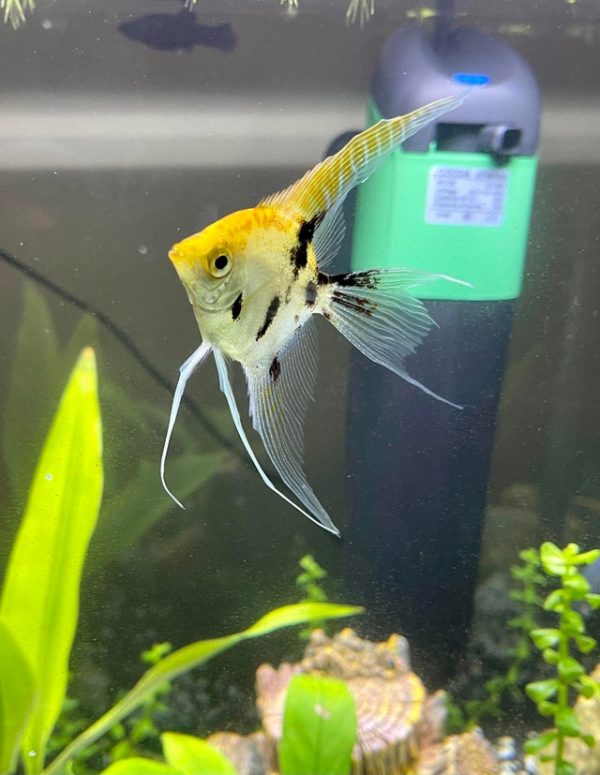
Angelfish Tank Size And Specifications
Talking about the tank size of angelfish, they are known to survive well in larger task environments. So, if you are planning to keep this fish species, you must have a 50 gallons tank for its proper growth.
Out of all the angelfish, tail angelfish can easily and quickly accommodate their size. That means they do not have much difficulty in living in a tank size that is not 50 gallons.
The minimum tank size that an angelfish requires to survive without any hassle is 20 gallons. Therefore, you should keep them in at least 10 gallons of water. Also, the ideal tank shape for angelfish is rectangular.
Moving further, angelfish likes gentle water flow and bigger decor items in the tank where they can hide comfortably. More specifically, their decor should include driftwood and large broadleaf plants.
If you want, you can also cover the tank water area with smooth surface gravel and floating plants. These things will create a home-like atmosphere for the fish to live in without any stress.
The main idea behind creating an ideal living atmosphere for angelfish is replicating the wild environment. Thus, you must properly grow small and tall plants. Slow-growing plants like Java Fern are the first choice of tank owners who are keeping angelfish.
Generally, you can keep 5-6 angelfish together. But do not keep them alone. Always accompany them with compatible tank mates.
To increase the oxygenation in the tank, angelfish requires a real filter that can effectively create better oxygen levels for them in the tank.
Optimum Tank Size For Angelfish
The recommended tank size for angelfish is 55 gallons or large. You must never keep the angelfish in a tank that is less than 20 gallons because that won’t create a favorable living condition for this fish species.
Tank Shape For Angelfish
The ideal tank shape that you must have for housing angelfish is rectangular. That’s because this tank gives them enough space for living comfortably and growing.
Filter Type For Angelfish
Angelfish cannot survive without a filter because then the aquarium water won’t be clean enough for them to live. Also, then the oxygen level won’t be enough for them. Thus, it’s important to use a real filter in the tank to keep them alive.
Substrate For Angelfish
As far as the substrate is considered, angelfish requires smooth surface gravel and medium grade to live comfortably.
How Many Angelfish For 50 Gallons Tank
Ideally, it’s suggested to keep 1 angelfish per 50 gallons tank.
Water Parameter For Angelfish
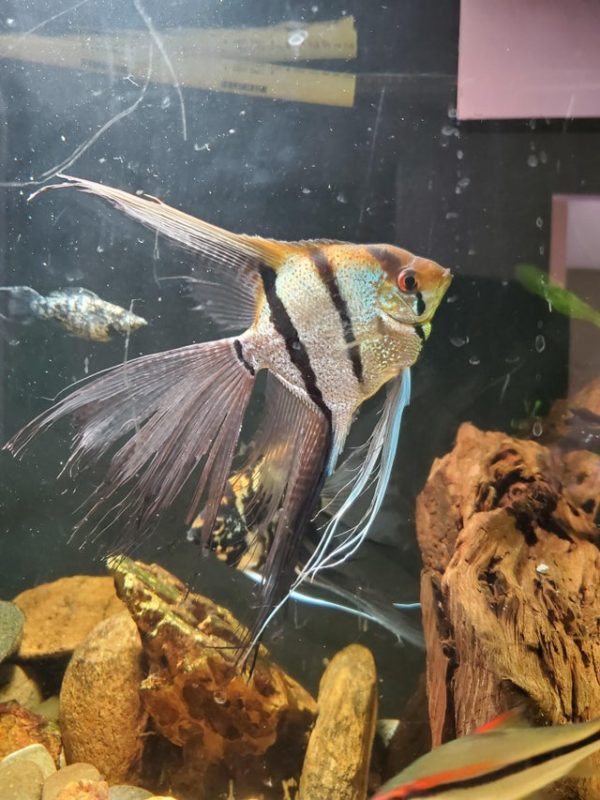
Water Temperature
The ideal water temperature for angelfish is between 78° and 84° F. During winters, you would have to install heaters in the aquarium to keep the tank water at the right temperature.
Ph Level
The perfect water pH level for the angelfish is 6.8 to 7.8. Angelfish likes to live in freshwater and can handle a variety of water parameters. But they prefer water that is slightly acidic and softer.
Water Hardness
Talking about the water hardness, angelfish likes water hardness between 3° and 8° dKH (54 to 145 ppm).
Angelfish Tank Landscape
If you want to keep angelfish, you must try to keep them in a tank that is 55 gallons or more. That’s because if the tank is smaller, then the angelfish might not be able to live comfortably.
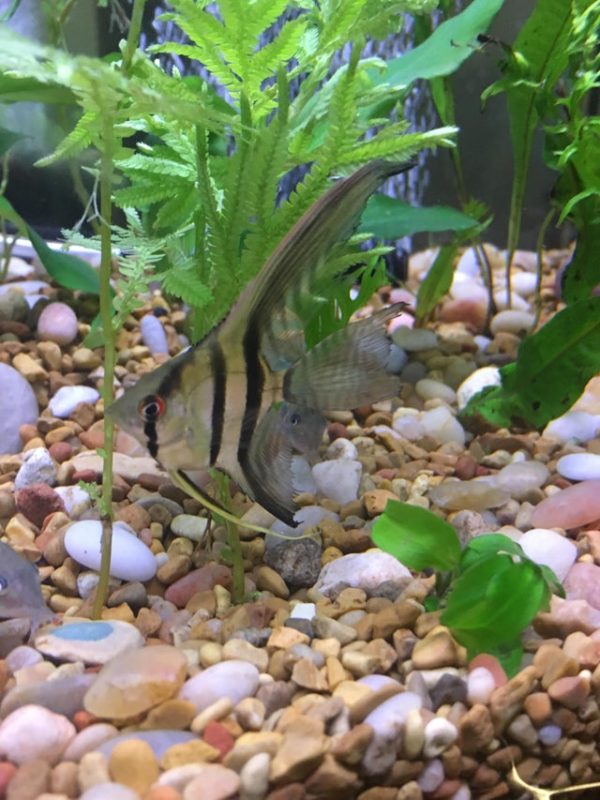
Talking about the setup, you can put decorations like broadleaf plants and driftwood. Also, you must try to maintain a gentle water flow.
Best Plant For Angelfish
If you are keeping angelfish, you should always put plants in the tank that offer some benefits to them. Commonly kept plants in the angelfish tank are Java Fern, Jungle Vallisneria, Java Moss, Water Wisteria, Water Sprite, and more.
Worst Plant For Angelfish
You must avoid keeping plants that are too small. That’s because the fish might eat them, and the plant’s purpose won’t be fulfilled. Also, plants that are too tall should be avoided because they can stop the entrance of fresh light in the tank.
Decoration For Angelfish Tank
Angelfish are known to like certain types of decorations in their tank, including rocks and driftwood. Also, large vertical standing rocks are the right choice because they offer the fish enough place to hide.
Lighting For Angelfish
Angelfish are freshwater species. Thus, they have very specific needs. As far as the lightning is considered, they need around 8 to 12 hours of light exposure.
Nitrogen And Other Nutrient Requirements For Angelfish
Angelfish are on the delicate side. Thus, they must not be kept in a tank with a nitrate level of more than 10 ppm.
Feeding Angelfish
Best Diet For Angelfish
Angelfish are omnivorous species, but they mainly prefer a meat-based diet. In nature, they eat small crustaceans and aquatic invertebrates. In the aquarium, their diet can vary based on commercially formulated cichlid diets: flakes or pellets, and live, frozen, or dried food in the form of bloodworms, white-worms, and/or brine shrimp. Additionally, algae wafers and vegetables are also recommended for a plant source diet.
How Often Should You Feed Angelfish?
The feeding cycle of angelfish depends on their age. For instance, younger angelfish should be typically fed around 3 to 4 times a day. But when they grow big, i.e., once they reach their full matured size, you must reduce the number of times you feed them.
Angelfish Behavior And Temperament
If you are planning to keep angelfish, you must know that they are timid in nature. Thus, they get easily scared of loud noises. In addition, they are community fish, but then they get quite aggressive when around other fish.
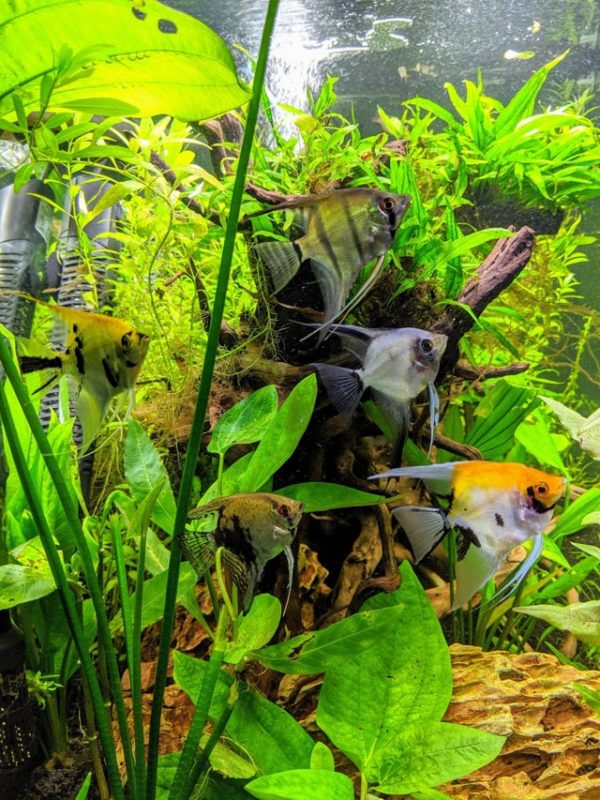
Are Angelfish Lone Or Societal In Nature
The young angelfish can live comfortably in the group. But the adult version likes to live alone.
Angelfish Tank Mates
Ideal Angelfish Tank Mates
Angelfish are known to live in groups, but this doesn’t mean that they can live with any kind of fish. You must always keep angelfish with companions that do not harm them. For instance, Boesemani rainbow fish, catfish, fire eel, dwarf gourami, zebra loaches, and more.
Here’s a complete list of fish that angelfish are comfortable living with.
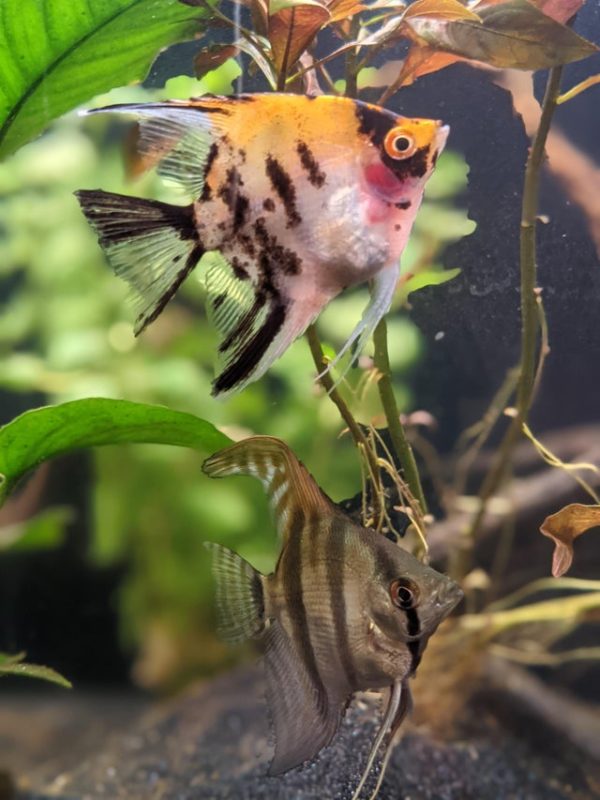
Bad Tank Mates For Angelfish
While angelfish are known to survive comfortably with a variety of fish, you must avoid housing them with aggressive fish. These include big cichlids and Oscars.
Here’s a complete list of angelfish fish that are uncomfortable living with.
Breeding Angelfish
Angelfish breed in pairs, and breeding should start in a separate breeding tank since it is hard to distinguish the males from the females. Genital papillae of male angelfish can be seen only during mating periods; however, males tend to be more aggressive than females as well. A healthy angelfish selection is very important for breeding; genetically weakfish should be eliminated from the tank.
For a start, six young angelfish should be moved in a separate tank and allowed to choose mates. Breeding pairs also can be purchased from the store to make the breeding process faster. Spawning can be observed when the female angelfish deposits eggs and the male fertilizes each egg.
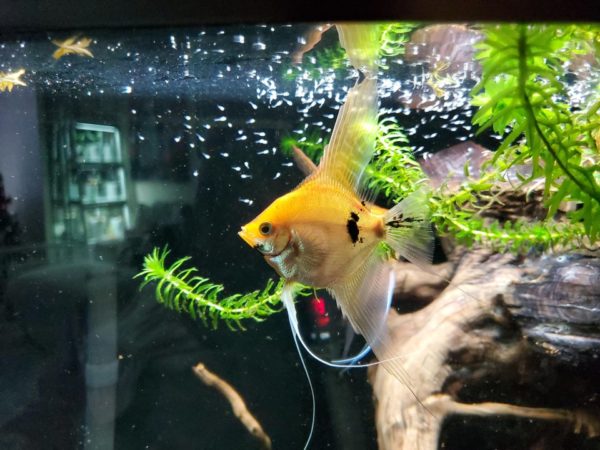
After the breeding is complete, the adult angelfish should be transferred to the community tank because sometimes parents eat the eggs and newborn fry. In the breeding tank, water should be clean and of the highest quality with a normal water temperature.
Angelfish Breeding Level
Breeding angelfish is rather easy than difficult.
Angelfish Sexual Dimorphism
To distinguish between male and female fish, you can check the size of the tube. In females, the tube will be thicker than in males.
Angelfish Common Diseases
If the aquarium water is clean and not overcrowded, the angelfish will, most likely, avoid disease. The most common angelfish diseases are the Angelfish virus, Flagellates, Angelfish parasites, and capillary symptoms. Angelfish virus is a deadly disease that can easily infect the whole population. In 2-3 days, when the symptoms (clamped fins, excess slime, lifelessness) appear, the fish should be moved into the quarantine tank.
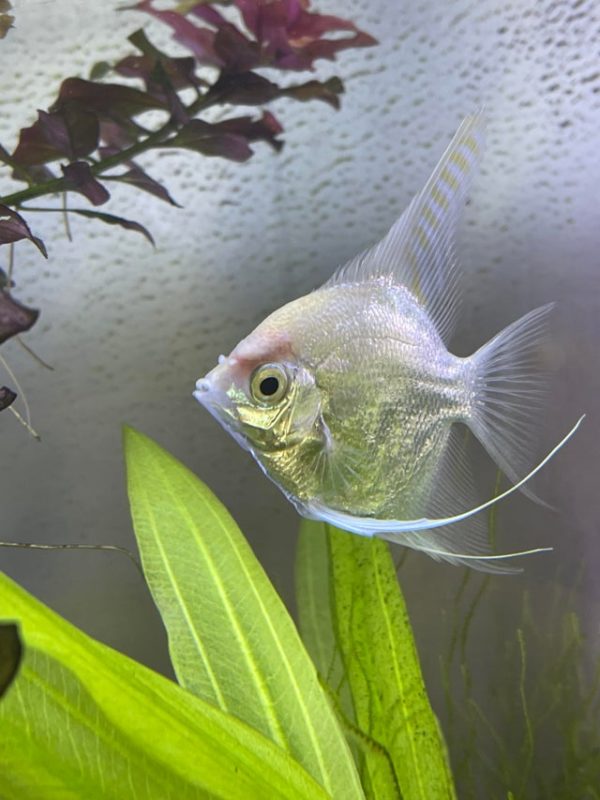
If the fish is still manifesting the symptoms, it should be destroyed. Survival from the disease depends on the fish’s immune system because the viral disease has no medication. Protozoans cause flagellates and manifest when the fish are under stress, such as when overcrowding exists, poor water quality, and/or limited food.
Hexamita can occur in all angelfish in the wild, whereas an outbreak causes a significant problem. If the fish exhibits white feces and decreased appetite without any external symptoms, it should be separated into a quarantine tank until the condition gets better.
Parasites, such as the common Capillaria and gill flukes, are another important health problem. Capillaria is a worm-like hair about one inch in size, and the eggs can be found in the feces of the fish.
Disease Treatment
Before treating any of the diseases, an angelfish may contract, consult a medical professional first. Additionally, some practical information can help to prevent the fish from disease. High aquarium temperatures may be useful if there is a parasite problem, whereas not for viral and bacterial diseases. If you find your fish has contracted a disease, be sure to investigate the rest of the species in the aquarium as well to avoid an outbreak.
Facts About Angelfish
- Angelfish can be aggressive
- The aquarium angelfish is available in almost all the color
- While angelfish are carnivores in nature, you should give them a mixed diet.
- Remember that introducing an angelfish to the fish tank will take time.
- Lastly, angelfish are prone to diseases.
Is Angelfish Right For You?
Angelfish is a friendly fish that can live comfortably in the tank. You can have a 50 gallons tank to house healthy and happy angelfish. Also, these fish species do not have high maintenance demands.
But when winter arrives, you must equip their tank with a heater. It will ensure the proper temperature in the tank, making the fish feel comfortable.
So, all in all, keeping angelfish in the tank is a good idea. And when you are keeping them, you can also add compatible tank mates and plants to maintain a healthy living condition.
Frequently Asked Questions
Are Angelfish Aggressive?
If you are keeping angelfish, remember that they are generally peaceful. But then they can sometimes get aggressive towards one other, which can create an issue.
What Fish Can Live With Angelfish?
Angelfish are friendly in nature. That means they can live with different fish species. But make sure that the fish you choose to house is not too small or too big. If the housing fish is small, angelfish might eat it, and if the fish is large, it might injure angelfish.
Are Angelfish Good For Beginners?
Beginners who have recently started keeping a tank should consider starting their fish-keeping journey with angelfish because it’s easy to maintain. But remember that this fish can easily fall sick.
How Long Does It Take For Angelfish To Reach Its Full Length?
Angelfish can take around a year to reach its maximum growth.
Conclusion
Whether you are a beginner or are keeping fish for a while, you will like angelfish. That’s mainly because this fish species is easy to take care of. Also, it is friendly. Thus, you can keep multiple fish with it in the same tank.

1 thought on “Angelfish 101: Care, Die, Breeding, Diseases, Treatment, Etc.”
Amazing information for starter